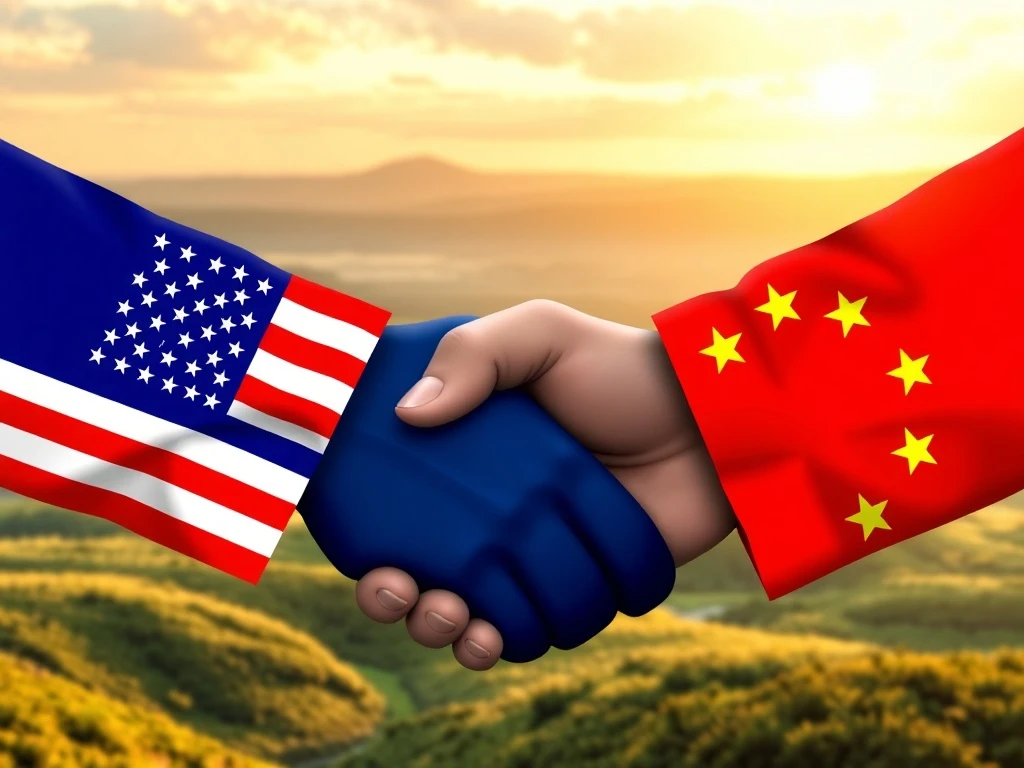Historic Trump EU Trade Deal: Averted Tariff War & $600B Investment Reshapes Global Trade

In the dynamic world of global finance, every major geopolitical shift, especially in trade, sends ripples across markets, including the cryptocurrency space. While not directly about digital assets, the stability of traditional economies and international relations significantly impacts investor confidence and liquidity. The recent announcement of a monumental Trump EU trade deal stands as a prime example, signaling a crucial de-escalation that could foster a more predictable environment for global capital flows. Let’s dive into the details of this pivotal agreement and understand its far-reaching implications.
The Breakthrough: Trump EU Trade Deal Details Unveiled
After months of tense negotiations that kept global markets on edge, U.S. President Donald Trump and European Commission President Ursula von der Leyen have officially confirmed a significant trade agreement set to reshape transatlantic commerce. Announced on July 28, 2025, this deal is a strategic move to prevent a full-blown tariff war averted that threatened to destabilize economies on both sides of the Atlantic. The core of the agreement revolves around several key commitments:
- Significant Tariff Reduction: A 15% across-the-board tariff rate will be applied to EU imports to the U.S., a drastic reduction from the previously threatened 30% rate. This adjustment is reciprocal, applying uniformly to U.S. exports to the EU as well.
- Massive EU Investment: The European Union has pledged a staggering $600 billion investment in American industry, aimed at bolstering U.S. manufacturing and job creation.
- Energy and Military Procurement: The EU committed to procuring $150 billion in U.S. energy and military equipment, aligning with the U.S. strategy to reduce reliance on foreign supply chains.
- Market Access: The agreement includes provisions for the EU to open its markets further to U.S. goods, facilitating tariff-free trade for American products among EU member states once they enter the bloc.
This breakthrough comes just days before a critical August 1 deadline, underscoring the high-stakes nature of the negotiations. Commerce Secretary Howard Lutnick confirmed that no further extensions would have been granted, adding immense pressure to finalize the agreement.
Averting a Tariff War: The Crucial 15% Rate Cut
The specter of an escalating tariff war averted was a major concern for businesses and consumers worldwide. Prior to this deal, the U.S. had already imposed significant tariffs, including 50% on EU steel and aluminum and 25% on cars and car parts. In response, the EU was preparing retaliatory measures on approximately $100 billion of American exports, targeting iconic products like aircraft and bourbon whiskey. The economic consequences of such an escalation would have been severe, disrupting supply chains, increasing consumer costs, and dampening global economic growth.
The new 15% tariff rate represents a significant concession from both sides, designed to stabilize immediate trade tensions and prevent a tit-for-tat escalation. Here’s a quick comparison of the previous threats versus the new reality:
| Trade Category | Previous U.S. Tariffs (Threatened/Existing) | New Agreed Tariff Rate |
|---|---|---|
| General EU Imports | Up to 30% (Threatened) | 15% |
| Steel & Aluminum | 50% (Existing) | 15% |
| Cars & Car Parts | 25% (Existing) | 15% |
This reduction not only provides immediate relief to industries but also sends a strong signal of a commitment to cooperative trade relations, fostering a more predictable environment for transatlantic trade.
Strengthening Transatlantic Trade: EU’s Massive Investment Pledge
Beyond tariff adjustments, a cornerstone of this agreement is the EU’s commitment to a colossal $600 billion investment in American industry. This pledge is designed to align with President Trump’s broader economic strategy, which prioritizes bolstering domestic manufacturing and reducing reliance on foreign supply chains. Additionally, the EU’s commitment to purchase $150 billion in U.S. energy and military equipment further reinforces this strategic alignment, promising a significant boost to specific American sectors.
The scale of this investment highlights the EU’s willingness to engage deeply with U.S. economic priorities to secure a favorable trade environment. For industries in the U.S., this could translate into new jobs, increased production capacities, and technological advancements. This influx of capital and procurement signals a renewed focus on strengthening economic ties and ensuring the long-term viability of transatlantic trade partnerships.
Analyzing the US EU Agreement: Hopes, Hurdles, and Leverage
While the immediate impact of the US EU agreement is positive, analyses from Wall Street and economic experts offer a more nuanced perspective. The $600 billion investment pledge, while impressive on paper, has drawn skepticism regarding its feasibility. Analysts recall similar challenges with the U.S.-Japan trade agreement, which included a $550 billion investment offer from Tokyo that has yet to fully materialize in tangible, verifiable commitments. Treasury Secretary Scott Bessent had previously lauded Japan’s offer as a model, but the lack of binding enforcement mechanisms for the EU’s investment pledges raises questions about accountability and deliverability.
President Trump’s trade diplomacy, characterized by a preference for bilateral negotiations over multilateral frameworks, is clearly evident in this deal. He has consistently leveraged the threat of tariffs as a powerful bargaining tool to secure favorable terms for U.S. industries. This approach, while effective in achieving specific concessions, also creates periods of significant uncertainty and volatility for global markets.
The agreement also reflects a strategic focus on specific sectors. The inclusion of energy and defense purchases aligns perfectly with the U.S. administration’s goals of strengthening domestic manufacturing and national security. However, it’s notable that pharmaceuticals were explicitly excluded from the agreement, with President Trump stating that drug price negotiations would remain a separate issue. This signals that despite the comprehensive nature of this deal, some fundamental disagreements and strategic priorities remain unresolved, leaving potential for future friction.
Economic Leverage and Future Implications
The successful negotiation of this deal underscores the power of economic leverage in modern trade diplomacy. By setting firm deadlines and employing the credible threat of punitive tariffs, the U.S. administration was able to extract significant commitments from the EU. This strategy, though controversial, has yielded a framework that stabilizes immediate trade tensions and avoids a damaging escalation.
However, the long-term effectiveness of the agreement hinges critically on the EU’s ability to meet its ambitious investment targets. The absence of legally enforceable mechanisms for these commitments means that their realization will depend heavily on political will and economic conditions within the EU. Furthermore, broader structural issues in U.S.-EU trade relations, such as market access for digital services, data privacy regulations, and other regulatory differences, remain unaddressed. These complex issues could very well resurface in future negotiations, indicating that while this deal is a significant step, it is likely not the final chapter in transatlantic trade discussions.
The precedent set by this agreement is also noteworthy for other U.S. trade partners. Treasury Secretary Bessent has indicated that ongoing discussions with Chinese officials are expected to follow a similar dynamic of tariff-based pressure. This suggests that the U.S. administration will continue to employ its strategy of direct pressure and bilateral deals to reshape global trade relationships in the coming years.
In conclusion, the Trump EU trade deal represents a critical moment in international economic relations. By averting a destructive tariff war and securing substantial investment pledges, it has brought immediate stability to transatlantic commerce. While questions about the long-term enforceability of commitments and the resolution of deeper structural issues persist, this agreement undeniably marks a significant win for de-escalation and strategic economic partnership. For the broader financial landscape, including the crypto markets, such stability provides a more fertile ground for growth and innovation, reminding us how interconnected our global economy truly is.
Frequently Asked Questions (FAQs)
Q1: What was the main outcome of the Trump EU trade deal?
The main outcome was the averting of a major transatlantic tariff war. The deal includes a 15% across-the-board tariff rate for EU imports to the U.S. (and vice-versa) and a substantial $600 billion investment pledge from the EU into American industry, alongside $150 billion in U.S. energy and military equipment procurement.
Q2: What was the significance of the 15% tariff rate cut?
The 15% tariff rate cut is significant because it’s a drastic reduction from the previously threatened 30% rate and existing higher tariffs (e.g., 50% on steel/aluminum). It effectively prevents a costly escalation of retaliatory tariffs, stabilizing trade relations and providing relief to industries on both sides.
Q3: What is the EU’s $600 billion investment pledge?
The EU’s $600 billion investment pledge is a commitment to invest in American industry. This is intended to boost U.S. manufacturing, create jobs, and align with President Trump’s strategy of strengthening domestic production and reducing reliance on foreign supply chains.
Q4: Are there any unresolved issues from this US EU agreement?
Yes, while the deal addresses immediate tariff concerns, some key issues remain unresolved. Notably, pharmaceuticals were explicitly excluded from the agreement, meaning drug price negotiations are still a separate matter. Broader structural issues like market access for digital services and regulatory differences also persist and may resurface in future discussions.
Q5: How does this deal affect future U.S. trade policy?
This deal sets a precedent for U.S. trade policy, reinforcing the administration’s preference for bilateral negotiations and the use of tariffs as a bargaining tool. Discussions with other trade partners, such as China, are expected to follow a similar dynamic of tariff-based pressure to secure favorable terms for U.S. industries.






